
Featured Breeder
Hisato Nogami(Nogami Koi Farm) |
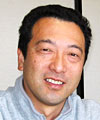 |
Mr. Nogami, present head of Nogami Koi Farm located in Muikamachi, Nagaoka city, gained training as a staff at Dainichi Koi Farm during its peak for fifteen years. He followed in the footsteps of Nogami Koi Farm in 1994. He did receive damages from the Chuetsu Earthquake of 2004 and lost some oyagoi, but with his passion for producing beautiful “Nogami Koi,” he has pulled everything back together. He currently produces Kohaku and Showa Sanshoku.
|
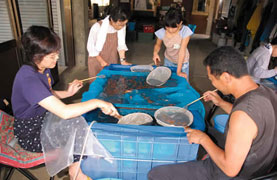 Nogami Koi Farm was founded by forerunner, Hisayuki Nogami in 1968. Our family was originally a farm family, but when my father married the elder sister of Mr. Minoru Mano from Dainichi Koi Farm, we started to hear a lot about Nishikigoi whenever there were reunions such as Buddhist sermons or festivals, and we developed an interest in them. We at first produced small quantities of Nishikigoi and then went on to build a Koi farm. I of course was in contact with Nishikigoi from a young age, but it wasn’t until after I graduated from high school in 1979 and began to receive training at Dainichi Koi Farm that I seriously started working in that business. After fifteen years of training, I took over Nogami Koi Farm. During the initial years, we produced Kohaku and Taisho Sanshoku, but now that we have lost some oyagoi from the Niigata Chuetsu Earthquake of 2004, I try to “concentrate on what I do best.” So I have limited our production down to two varieties; 60% of it is Kohaku and 40% is Showa Sanshoku. Nogami Koi Farm was founded by forerunner, Hisayuki Nogami in 1968. Our family was originally a farm family, but when my father married the elder sister of Mr. Minoru Mano from Dainichi Koi Farm, we started to hear a lot about Nishikigoi whenever there were reunions such as Buddhist sermons or festivals, and we developed an interest in them. We at first produced small quantities of Nishikigoi and then went on to build a Koi farm. I of course was in contact with Nishikigoi from a young age, but it wasn’t until after I graduated from high school in 1979 and began to receive training at Dainichi Koi Farm that I seriously started working in that business. After fifteen years of training, I took over Nogami Koi Farm. During the initial years, we produced Kohaku and Taisho Sanshoku, but now that we have lost some oyagoi from the Niigata Chuetsu Earthquake of 2004, I try to “concentrate on what I do best.” So I have limited our production down to two varieties; 60% of it is Kohaku and 40% is Showa Sanshoku.
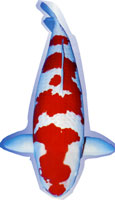 There were many things to learn from Dainichi Koi Farm, the best farm around at the time. I especially learned a lot from forerunner, Mr. Minoru Mano. He didn’t teach me much in words, but by accompanying him, I watched and learned how to appreciate and treat Nishikigoi and also how to relate with the customers. Above all things, I learned how to cherish Nishikigoi, and that is what still remains in me as a great asset. He taught me to care for every Koi equally, not just for an expensive Koi that anybody and everybody would value. I will never forget having learned the importance of treating the least expensive Koi as a good Koi and of doing my best in helping a Koi if it becomes ill, no matter how bad it may be. He also made sure that his customers were warmly welcomed. He carefully organized the greenhouse because “Nishikigoi are works of art, so we need to keep a comfortable environment.” I cannot describe how much I learned from seeing him putting effort into strengthening the artistry of Nishikigoi. There were many things to learn from Dainichi Koi Farm, the best farm around at the time. I especially learned a lot from forerunner, Mr. Minoru Mano. He didn’t teach me much in words, but by accompanying him, I watched and learned how to appreciate and treat Nishikigoi and also how to relate with the customers. Above all things, I learned how to cherish Nishikigoi, and that is what still remains in me as a great asset. He taught me to care for every Koi equally, not just for an expensive Koi that anybody and everybody would value. I will never forget having learned the importance of treating the least expensive Koi as a good Koi and of doing my best in helping a Koi if it becomes ill, no matter how bad it may be. He also made sure that his customers were warmly welcomed. He carefully organized the greenhouse because “Nishikigoi are works of art, so we need to keep a comfortable environment.” I cannot describe how much I learned from seeing him putting effort into strengthening the artistry of Nishikigoi.
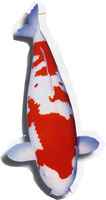 What I had the most trouble with after becoming independent is the selection and crossing of oyagoi. I thought that I had understood everything being trained by Dainichi’s forerunner for quite a long time, but it was different when trying it for myself. Koi is not a product made by human beings, so even if I use the same oyagoi, the results can be different. That is why I really wanted to create the “Nogami Koi” in my own way. At Dainichi I was always told “to take plenty of time to raise a Koi, to be confident of your own Koi, and not be affected so much by results of a single year.” I have always kept that advice in my head and have put all of my efforts in the crossing of oyagoi year after year. First, I tried to make a Nishikigoi that would please the past generations of Dainichi than the public. What I had the most trouble with after becoming independent is the selection and crossing of oyagoi. I thought that I had understood everything being trained by Dainichi’s forerunner for quite a long time, but it was different when trying it for myself. Koi is not a product made by human beings, so even if I use the same oyagoi, the results can be different. That is why I really wanted to create the “Nogami Koi” in my own way. At Dainichi I was always told “to take plenty of time to raise a Koi, to be confident of your own Koi, and not be affected so much by results of a single year.” I have always kept that advice in my head and have put all of my efforts in the crossing of oyagoi year after year. First, I tried to make a Nishikigoi that would please the past generations of Dainichi than the public.
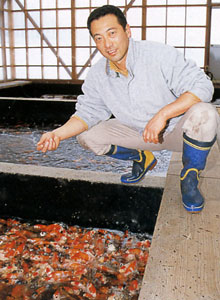 I currently focus on Kohaku. I continue producing Kohaku because I always have been fond of them but also because I was intrigued by the “Kamenoko Kohaku” I saw the first year I was at Dainichi. I still remember that strong impression I felt at that moment; the quality of beni was like that of a stained-glass, and the red was like a reddish rouge of the cherry blossom, not a deep red. I have seen many brand Koi since then, but I don’t think there were any that would surpass it. That is how beautiful it was. And that is the reason I insist on making beautiful Nishikigoi comparable to the Kamenoko Kohaku. A big body conformation is of course attractive, but Nishikigoi are pieces of art, so they have to be beautiful. I think the number one priority is to raise “beautiful” Koi than “big” Koi. I currently focus on Kohaku. I continue producing Kohaku because I always have been fond of them but also because I was intrigued by the “Kamenoko Kohaku” I saw the first year I was at Dainichi. I still remember that strong impression I felt at that moment; the quality of beni was like that of a stained-glass, and the red was like a reddish rouge of the cherry blossom, not a deep red. I have seen many brand Koi since then, but I don’t think there were any that would surpass it. That is how beautiful it was. And that is the reason I insist on making beautiful Nishikigoi comparable to the Kamenoko Kohaku. A big body conformation is of course attractive, but Nishikigoi are pieces of art, so they have to be beautiful. I think the number one priority is to raise “beautiful” Koi than “big” Koi.
My current goal is to not only produce good Koi but to make Nishikigoi that will win prizes at shows and to establish a brand name. I want people to say that they want this Koi because it is beautiful, that they want this Koi even if it medium-sized. Not because a medium size one is the only option, because they want that medium-sized Koi in specific. Since I am a Niigata breeder, I want Koi lovers to say “Niigata Nishikigoi are great.” Niigata is the birthplace of Nishikigoi, so I hope people will want to come to Niigata because there are Koi that have potential of winning prizes at shows and because there are numerous varieties of Nishikigoi.
I would like to say to worldwide Koi lovers that we, Niigata breeders, have been working hard to produce fine Koi after the quake. I just hope you will come visit us in Niigata. And I hope you will choose a Koi that appeals to you and raise it with a lot of affection.
|
|

 Nogami Koi Farm was founded by forerunner, Hisayuki Nogami in 1968. Our family was originally a farm family, but when my father married the elder sister of Mr. Minoru Mano from Dainichi Koi Farm, we started to hear a lot about Nishikigoi whenever there were reunions such as Buddhist sermons or festivals, and we developed an interest in them. We at first produced small quantities of Nishikigoi and then went on to build a Koi farm. I of course was in contact with Nishikigoi from a young age, but it wasn’t until after I graduated from high school in 1979 and began to receive training at Dainichi Koi Farm that I seriously started working in that business. After fifteen years of training, I took over Nogami Koi Farm. During the initial years, we produced Kohaku and Taisho Sanshoku, but now that we have lost some oyagoi from the Niigata Chuetsu Earthquake of 2004, I try to “concentrate on what I do best.” So I have limited our production down to two varieties; 60% of it is Kohaku and 40% is Showa Sanshoku.
Nogami Koi Farm was founded by forerunner, Hisayuki Nogami in 1968. Our family was originally a farm family, but when my father married the elder sister of Mr. Minoru Mano from Dainichi Koi Farm, we started to hear a lot about Nishikigoi whenever there were reunions such as Buddhist sermons or festivals, and we developed an interest in them. We at first produced small quantities of Nishikigoi and then went on to build a Koi farm. I of course was in contact with Nishikigoi from a young age, but it wasn’t until after I graduated from high school in 1979 and began to receive training at Dainichi Koi Farm that I seriously started working in that business. After fifteen years of training, I took over Nogami Koi Farm. During the initial years, we produced Kohaku and Taisho Sanshoku, but now that we have lost some oyagoi from the Niigata Chuetsu Earthquake of 2004, I try to “concentrate on what I do best.” So I have limited our production down to two varieties; 60% of it is Kohaku and 40% is Showa Sanshoku.




